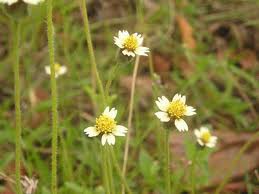| PlantID | 0131 |
| Botanical Name | Tridax procumbens |
| Common Name | Ghamra |
| Classification | | Kingdom: | Plantae | | Subkingdom: | Tracheobionta | | Division: | Magnoliophyta | | Class: | Magnoliopsida | | Subclass: | Asteridae | | Order: | Asterales | | Family: | Asteraceae | | Genus: | Tridax | | Species: | procumbens |
|
| Part used | Whole plant, leaves. |
| Medicinal Properties | Antiviral, antibiotic, wound healing activity, anti-inflammatory, anticoagulant, antifungal, insect repellent, antioxidant and anti-diabetic.
|
| Medicinal Use | Useful in jaundice, bronchial catarrh, diarrhoea, dysentery, inflammation, ulcers, anal fistula, and hemorrhoids. It promotes hair growth. Leaf juice can be used to cure fresh wounds, to stop bleeding. Leaf extract cures liver disorders.
|
| Chemistry | Leaves juice: dexamethasone. Isolation of methyl 14-oxooctadecanoate, methyl 14-oxononacosanoate, 3-methyl-nonadecylbenzene, heptacosanylcyclohexane carboxylate. Arachidic, behenic, lauric, linoleic, linolenic, myristic, palmitic, palmitoleic and stearic acids. |
| Cultivation | NA |
| Regional Habitat | Found along paths, roadsides and in the crevices of walls and rocks. Distribution: Throughout Rajasthan. |
| Description | A spreading annual herb grows up to 20 cm in height. Leaves: simple, opposite, serrate or dentate, acute, fleshy and pubescent. Flowers: daisylike yellow-centered white or yellow flowers with three-toothed ray. Fruits: hard achene covered with stiff hairs and having a feathery white pappus at one end. Seeds: numerous, small with tuft of silky hairs on one side for wind dispersal. Flowers and fruits appears throughout the year.
|
| Image |  |


